Hi Guys.
I have been handed a pair of ancient RS (radio spares) mosfet mono blocks from 1989 to refurbish.
These are the (claimed) 250watt modules with 42vac (60vdc) supply rails.
I have attached all the information I have for these.
If anyone has the rest of the article or biasing info I would be very appreciative.
I am of the opinion they are very minimalist in their design.
(I'm comparing to the David Tillbrook AEM6000 mosfet amps I used to have).
So if people can suggest any alterations, that would also be wonderful.
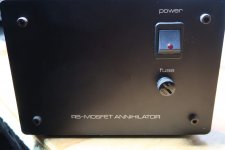
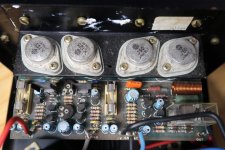
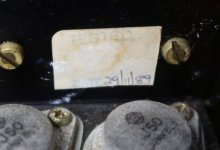
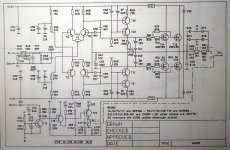
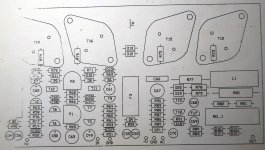
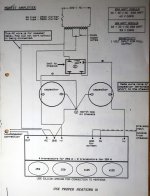
I have been handed a pair of ancient RS (radio spares) mosfet mono blocks from 1989 to refurbish.
These are the (claimed) 250watt modules with 42vac (60vdc) supply rails.
I have attached all the information I have for these.
If anyone has the rest of the article or biasing info I would be very appreciative.
I am of the opinion they are very minimalist in their design.
(I'm comparing to the David Tillbrook AEM6000 mosfet amps I used to have).
So if people can suggest any alterations, that would also be wonderful.






Last edited:
In my mind:
Beautiful: half-wave symmetrical.
Unnecessary, and disadvantageous: to chase the signal completely through the input differential amplifier (also T7 and T8) and also through T11 and T12. Here really a lot is left behind and additional "technical, artificial character" is picked up.
Bad: these Hitachi MosFets do sound terrible. I would replace them with any TO-247 types. They all will sound better.
Are already good PP amps, and beat easy any Accu or Krell or Levinson or something;-)
Have much much fun with these!
Beautiful: half-wave symmetrical.
Unnecessary, and disadvantageous: to chase the signal completely through the input differential amplifier (also T7 and T8) and also through T11 and T12. Here really a lot is left behind and additional "technical, artificial character" is picked up.
Bad: these Hitachi MosFets do sound terrible. I would replace them with any TO-247 types. They all will sound better.
Are already good PP amps, and beat easy any Accu or Krell or Levinson or something;-)
Have much much fun with these!
These were offered as a kit and as complete amps by a local electronics shop here in South Africa. They're relatively well-known locally.
You'll get some good info if you post on the SA forums here: https://www.avforums.co.za/
You'll get some good info if you post on the SA forums here: https://www.avforums.co.za/
Ta.
I had a look (and search) through the SA forums.
Not really much there.
I did find a fb page that gave me some basic info including biasing.
Nothing I saw filled me with enthusiasm for these things.
They seem a very half hearted design more to try and sell product.
I will advise my friend to do a basic recap, new trim pots, new supply caps, and swap out the input cap (c49 c50) for a 1uf poly rather than the current back to back electros.
I think more than that is overkill.
I had a look (and search) through the SA forums.
Not really much there.
I did find a fb page that gave me some basic info including biasing.
Nothing I saw filled me with enthusiasm for these things.
They seem a very half hearted design more to try and sell product.
I will advise my friend to do a basic recap, new trim pots, new supply caps, and swap out the input cap (c49 c50) for a 1uf poly rather than the current back to back electros.
I think more than that is overkill.
There is no golden rule or inviolable law for setting the quiescent current.
I would use the heatsink and power supply as a guide and set the bias as high as possible. The sound of PP amplifiers with higher bias seems more full-bodied and elaborated, less noisy and flat and tinnitus-inducing - compared to itself and a smaller bias.
I would use the heatsink and power supply as a guide and set the bias as high as possible. The sound of PP amplifiers with higher bias seems more full-bodied and elaborated, less noisy and flat and tinnitus-inducing - compared to itself and a smaller bias.
The design topology is similar to the K.Lang 20W class-A mosfet amplifer, originally published in (German?) Elrad magazine, and re-printed in TAA, probably mid -80s
The article is available for download here: https://linearaudio.nl/sites/linearaudio.net/files/lang class A.pdf
Also some info here: https://www.diyaudio.com/community/threads/lang-20w-class-a-amplifier.370733/
As for the bias current, the late Erno Borbely recommended 100-300 mA per output pair and minimum 500 total for his 50W amp.
Hence I would expect somewhere between 200-600 mA in your amp. Does the amp have sufficient cooling for this?
The article is available for download here: https://linearaudio.nl/sites/linearaudio.net/files/lang class A.pdf
Also some info here: https://www.diyaudio.com/community/threads/lang-20w-class-a-amplifier.370733/
As for the bias current, the late Erno Borbely recommended 100-300 mA per output pair and minimum 500 total for his 50W amp.
Hence I would expect somewhere between 200-600 mA in your amp. Does the amp have sufficient cooling for this?
Well spotted, The Lang amp and also the Elector Crescendo series amps that use the same topology have the VAS stage connected to the "input" side of the LTP, not the "feedback" side as illustrated in the RS schematic.I feel sure the schematic has an error the input to the drivers from the input diff pairs is shown from the wrong collectors
Trev
250W from 60V rails increased voltage for the input stage seem optimistic to me unless into 4-ohm. The Audio express article on Haffler-220 upgrade by Bob Cordell Rick Savas indicate 120W/8 ohm at similar voltages. BTW - This article advices 200mA/output pair for a total of 400mA using the same family Mosfet (2SK134 / 2SJ49)
Do output devices really have specific "sound"?these Hitachi MosFets do sound terrible.
I do not think that lateral mosfets sound terrible in fact I have used a hitachi HMA7500 mk1 for the last 40 years Its only just been retired sounded really nice !
My new power amp is a custom made Crimson now that sounds stunning
My new power amp is a custom made Crimson now that sounds stunning
The heatsink is way to small for a decent bias on a 100w/8r mosfet amp in my view.
It's a little smaller than the front panel as theres power / input / speaker terminals under the heatsink.
The attached is from the SA audio company that sells kits and completed units.
This gent is also mentioned as the guy that does modifications for these.
But it seems he keeping mum about what he does.
Fair enough. He developed the changes.
The photos of the boards and general layout appear to be a direct copy.
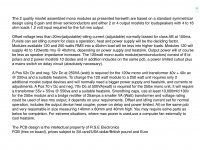
It's a little smaller than the front panel as theres power / input / speaker terminals under the heatsink.
The attached is from the SA audio company that sells kits and completed units.
This gent is also mentioned as the guy that does modifications for these.
But it seems he keeping mum about what he does.
Fair enough. He developed the changes.
The photos of the boards and general layout appear to be a direct copy.

The Maplin lateral mosfet amp with same outputs was 100mA bias current for one pair.
So I would assume for two pairs its 200mA.
So I would assume for two pairs its 200mA.
TO3 are coming to end of life at Profusion.Bad: these Hitachi MosFets do sound terrible. I would replace them with any TO-247 types. They all will sound better.
They recommend using TO247's.
Ummm .... Erno passed away?? When did that happen?...
As for the bias current, the late Erno Borbely recommended 100-300 mA ...
Take a closer look at the structure. And look more closely at how "electricity", "current" works.Why would a TO3 sound worse than a TO247 surely the die inside is the same ?
I bougth a 7500 II, listened to it for 3 minutes, then ripped out everything except the transformers and heatsinks. But the bad sound has little to do with the Hitachis.I do not think that lateral mosfets sound terrible in fact I have used a hitachi HMA7500 mk1 for the last 40 years Its only just been retired sounded really nice !
My new power amp is a custom made Crimson now that sounds stunning
I liked the case;-)
Every single part has a specific sound;-)Do output devices really have specific "sound"?
To be honest the 7500 Mk11 is very different to the mk1 much more complex but that does not mean better
I used to be in the trade I am a qualified electrical engineer over 50 years in audio and know how electricity works but still dont understand why the package would change the sound
its just a more convenient and cheaper package option
I used to be in the trade I am a qualified electrical engineer over 50 years in audio and know how electricity works but still dont understand why the package would change the sound
its just a more convenient and cheaper package option
Since there are no emitter resistors, how do I measure the bias ?
Swap the rail fuses for a pair of resistors ? (this is what Mr Tillbrook did on his aem6000)
Swap the rail fuses for a pair of resistors ? (this is what Mr Tillbrook did on his aem6000)
The circuit from the 7500 MK1 already looks much better! So we already agree that the complexity of the circuits have an influence on the sound: the sound, the signal, is modulated by circuit, at least.To be honest the 7500 Mk11 is very different to the mk1 much more complex but that does not mean better
I used to be in the trade I am a qualified electrical engineer over 50 years in audio and know how electricity works but still dont understand why the package would change the sound
its just a more convenient and cheaper package option
We lack the methods to trace the sound of components. I would start with power diodes. As an electrical engineer, first build a couple of single ended amplifiers with ONE power supply only. In this power supply insert different diodes, just like that in rail. Little by little. Just swap them. And always listen diligently and take notes diligently. After some experience add power transistors. Later the consideration, why the things sound different;-)
But are the TO-247's really better? The TO-3's are nice because they're hermetically sealed and avoid unnecessary ageing from water ingress through the moulded plastic. One advantage the TO-247's might have is the thermal gradient, but that may mean they need a slightly different circuit or different heat sinks for a fair comparison.In my mind:
Beautiful: half-wave symmetrical.
Unnecessary, and disadvantageous: to chase the signal completely through the input differential amplifier (also T7 and T8) and also through T11 and T12. Here really a lot is left behind and additional "technical, artificial character" is picked up.
Bad: these Hitachi MosFets do sound terrible. I would replace them with any TO-247 types. They all will sound better.
Are already good PP amps, and beat easy any Accu or Krell or Levinson or something;-)
Have much much fun with these!
- Home
- Amplifiers
- Solid State
- RS mosfet amplifier information wanted